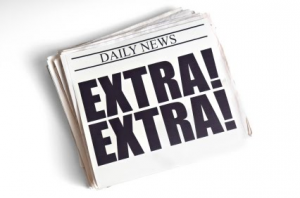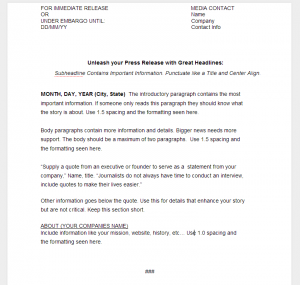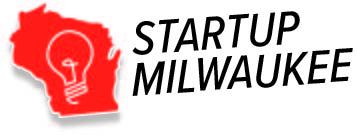
So you want to see your name in lights. Media coverage is one of the best and least expensive ways to let the world know about you and your company (or rock band, for that matter). The trouble with media coverage is that you can’t buy it or send a regular email to get it. With a couple of simple tools, you can create a press kit that will help you attract the attention of local media outlets. This is part 2 of a 3 part series. (If haven’t already, start with Part 1: The Media List.)
The keyword in news is new. It's easy to communicate your news to local media with the standard format of a press release. This format makes it easy for them to digest your information. A well written press release can make or break your media campaign.
The 11 Critical Parts of a Press Release:
1. Media contact: The contact person at your company for questions or interviews.
2. Release date: Most press releases are either: “FOR IMMEDIATE RELEASE,” or “UNDER EMBARGO UNTIL: Day, month, year.” (Under embargo means that the media should not publish the news until the embargo expires.)
3. Headline: The headline should catch the reader’s attention and contain the main topic of the post. A good headline goes a long way. Here’s five easy tricks to writing catchy headlines.
4. Sub-headline: This is a note or summary that contains other important information. Punctuate like a title and center align.
5. Dateline: "MONTH, DAY, YEAR (City, State)." The dateline is almost always bold and listed in that order.
6. Introductory paragraph: Write the most important information and any important details. If someone reads this paragraph and this paragraph only, they should know what the story is about.
7. Body paragraphs: These paragraphs contain more information and details. The body should be about two paragraphs maximum.
8. Quote: Supply a quote from an executive or founder. This can be used as a statement from your company in lieu of an interview.
9. Other information: This is for other details that are not critical to the story. Keep this section short.
10. "ABOUT [YOUR COMPANIES NAME]" Include information like your corporate mission, website, history, etc. This should be single spaced.
11. After the article, include three hash marks (###) to mark the end of the press release. (See example below.)

Stayed tuned for Part 3: The Press Kit
Part 1: 5 Easy Steps to Unlock Media Coverage
Part 3: The Press Kit
About the Author:
Steve Anderson is an entrepreneur who lives in Milwaukee, Wisconsin. Currently he is the COO of LessonLogs and the Founder of Laylines Consulting. He has helped numerous companies obtain seed stage funding and is a previous winner of Startup Weekend Madison. In addition, Steve has a Masters degree from the Wisconsin School of Business. Find him on Twitter: @LaylinesSteve




